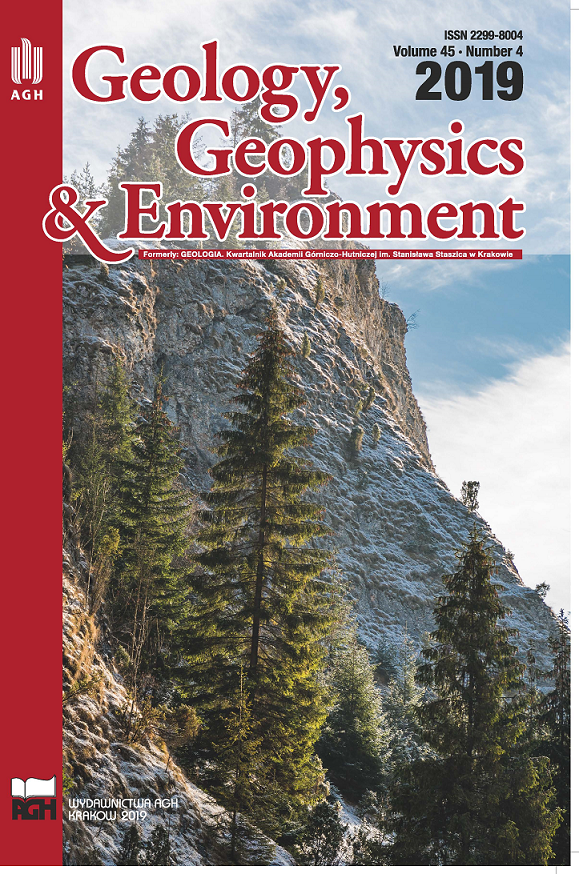Lithostratigraphic classification of the Tsodilo Hills Group: a Palaeo- to Mesoproterozoic metasedimentary succession in NW Botswana
DOI:
https://doi.org/10.7494/geol.2019.45.4.305Keywords:
lithostratigraphy, siliciclastic shelf, Proterozoic, BotswanaAbstract
The Tsodilo Hills Group strata exposed in the Tsodilo Hills are an association of metaarenites, metaconglomerates, quartz-mica schists, sandstone, red siltstone and sedimentary breccia deposited on an open siliciclastic marine shelf between the Late alaeoproterozic and Late Mesoproterozoic, and outcropping in NW Botswana. The uccession is dominated by three micaceous quartzite units interlayered with subordinate lenses and wedges of other rock types. Facies gradients from S to N are expressed by: decreasing content of muscovite at all levels of metasediment organisation from thin wedge-shaped units to thick quartzite complexes, as well as a decrease in pebble content and increase in arenaceous matrix in some metaconglomerate beds, matching regional palaeotransport direction. Well-rounded pebbles of extrabasinal rocks are flat, suggesting redeposition from a beach environment. Lenticular conglomeratic bodies with erosional lower boundaries represent infills of local incisions in the sandy bottom sediments. The abundance of laterally discontinuous lithological units reflects shelf palaeotopography controlled and modified by deposition and migration of large bed forms, ranging from megaripple marks (or submarine dunes) to sand waves. Deposition was influenced by tides and two regressive events. The older regression resulted in a marker unit of tidal mudflat-related red-bed facies: mudstone, siltstone, channel-fill sandstone and sedimentary breccia. The second regression is indicated by a tabular conglomerate marker reflecting increased input of coarse terrigenous material.
Downloads
References
Aagaard T., Greenwood B. & Nielsen J., 1997. Mean currents and sediment transport in a rip channel. Marine Geology, 140 (1–2), 25–45.
Antia E., 1994. Long-term and post-storm dynamic patterns of the subtidal rhythmic morphology along the East Frisian island coast, Germany. Geologie en Mijnbouw, 73 (1), 1–12.
Carney J.N., Aldiss D.T. & Lock N.P., 1994. The Geology of Botswana. Bulletin, 37, Geological Survey of Botswana, Lobatse.
Domokos G., Sipos A., Szabó T. & Várkonyi P., 2010. Pebbles, shapes, and equilibria. Mathematical Geosciences, 42 (1), 29–47.
Durian D.J., Bideaud H., Duringer P., Schröder A., Thalmann F. & Marques C., 2006. What is in a pebble shape? Physical Review Letters, 97 (2), 028001.
Ingram R.L., 1954. Terminology for the thickness of stratification and parting units. Geological Society of America Bulletin, 65, 937–938.
Key R.M. & Ayers N., 2000. The 1998 edition of the National Geological Map of Botswana. Journal of African Earth Sciences, 30, 427–451.
Mapeo R.B.M., Wendorff M., Ramokate L.V., Armstrong R.A., Mphinyane T. & Koobokile M., 2019. Zircon geochronology of basement granitoid gneisses and sedimentary rocks of the Tsodilo Hills Group in the Pan-African Damara Belt, western Botswana: age constraints, provenance, and tectonic significance. Journal of African Earth Sciences, 159, 103576.
Meixner H.M. & Peart R.J., 1984. The Kalahari Drilling Project. Bulletin, 27. Geological Survey of Botswana, Lobatse
Pflüger F. & Gresse P.G., 1996. Microbial sand chips – a non- -actualistic sedimentary structure. Sedimentary Geology, 102 (3–4), 263–274.
Reineck H.E. & Singh I.B., 1973. Depositional Sedimentary Environments: with Reference to Terrigenous Clastics. Springer-Verlag Berlin Heidelberg.
Singletary S.J., Hanson R.E., Martin M.W., Crowley J.L., Bowring S.A., Key R.M., Ramokate L.V., Direng B.B. & Krol M.A., 2003. Geochronology of basement rocks in the Kalahari Desert, Botswana, and implications for regional Proterozoic tectonics. Precambrian Research, 121, 47–71.
Vermaak C.F., 1962. Batawana Reserve – Bechuanaland Protectorate Geological Report. Johannesburg Consolidated Investment Company Ltd., Johannesburg.
Wendorff M., 2005. Outline of lithostratigraphy, sedimentation and tectonics of the Tsodilo Hills Group, a Neoproterozoic-Lower Palaeozoic siliciclastic succession in NW Botswana. Annales Societatis Geologorum Poloniae, 75 (1), 17–25.
Wentworth C.K., 1922. A scale of grade and class terms for clastic sediments. The Journal of Geology, 30 (5), 377– 392.
Wright E.P., 1956. The Tsodilo Hills (Ngamiland). EPW/15/56, Unpublished Report EPW/15/56. Geological Survey of Botswana, Lobatse.
Downloads
Published
Issue
Section
License
Authors have full copyright and property rights to their work. Their copyrights to store the work, duplicate it in printing (as well as in the form of a digital CD recording), to make it available in the digital form, on the Internet and putting into circulation multiplied copies of the work worldwide are unlimited.
The content of the journal is freely available according to the Creative Commons License Attribution 4.0 International (CC BY 4.0)










